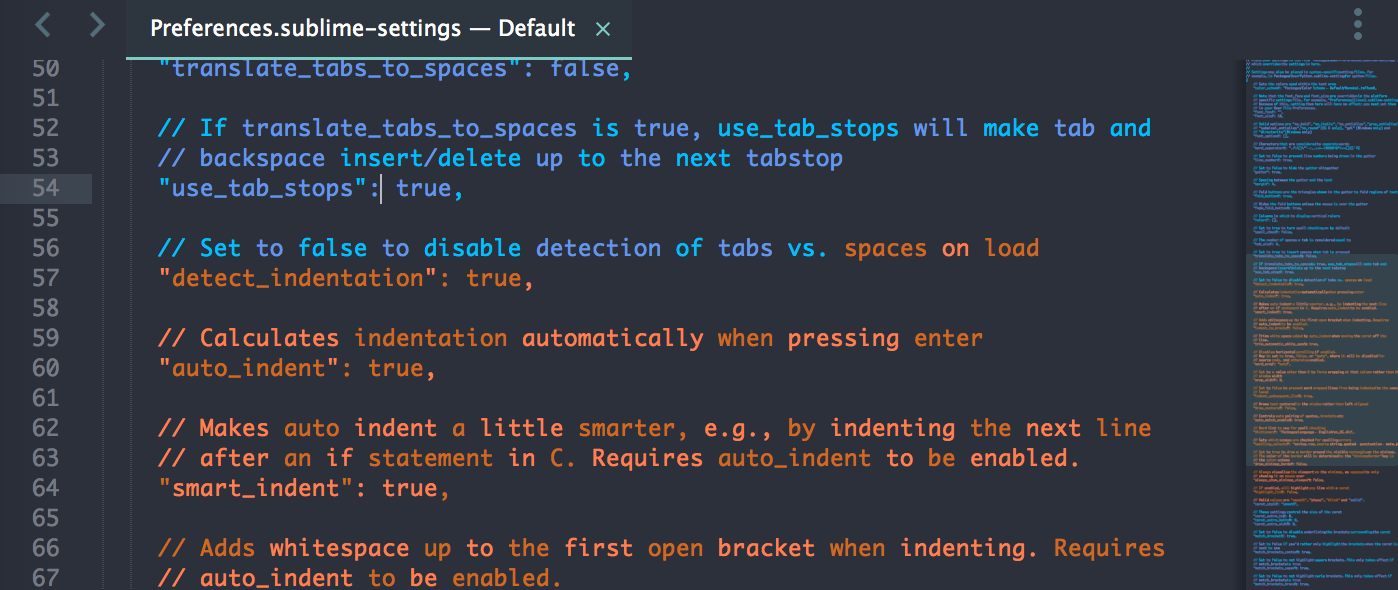This afternoon I spent some time with the free trial of theHopper Disassembler looking through the binary of Sublime Text 3. I found some interesting things and some undocumented settings.
Undocumented Settings
The most potentially useful and interesting thing I found were some undocumented settings for Sublime Text. A couple of them could even be useful to some people:
draw_shadows: A boolean that can disable the shadow effect when any line is longer that the window. I personally like effect but if you want a cleaner look or your window is only slightly wider than your text and the shadow effect kicks in early, you can use this setting.indent_guide_options:solid: This as an undocumented option that makes indent guides solid instead of dashed. Add this in addition to adraw_*option.draw_active_single: Likedraw_activebut only draws the innermost indent guide your cursor is in instead of guides for every indent level down to it.
draw_debug: A boolean that if true enables a special debugging text renderer. It seems to turn sections of the document either blue or red, and within the sections it turns tokens alternating light and dark shades of those colours. Note you have to set the setting to false to turn it off, not just delete it. These change sometimes when scrolling and editing but I can’t figure out when and why.wide_caret: This just acts like adding tocaret_extra_width, probably an old setting, not useful.
There’s also the undocumented command line flags:
--multiinstance: Starts a new instance of Sublime even if one is already running.--debug: Prints debug output to stdout, I think this is just the output that goes in the built-in console.
I discovered these settings by running strings on my Sublime Text.app/Contents/MacOS/Sublime Text
binary and looking near the things I knew where config options for things that looked like config
options, then trying them out.


Libraries Used
The Sublime Text release binaries don’t have symbol names stripped out, probably for debugging reasons, and for that I’m very grateful because it’s really cool. The assembly is still largely indecipherable to me, but there are some cool things I can find out.
From the function names I can also see some of the libraries used in the making of Sublime Text. Here’s a partial list:
- Skia: It’s been mentioned online this is used for rendering everything
- Google densehash: Faster hash map, used everywhere
- Oniguruma: Fallback for fancy regexes the custom engine can’t handle
- Boost
- Google breakpad
- CryptoPP/Crypto++
- leveldb: Used to store symbol indexes I think
- snappy: Fast compression, not sure what it is used for
- Hunspell
- YAML
- lzma
- Hunzip: Probably what is used to unzip the zipped up package format
- libtomcrypt
Internal names
I can also see some general architecture and what things are named. This is just cool trivia.
sregex: The custom super fast regex engine. I think the special feature is that it can search for many different regexes on one piece of text at the same time. Because when I wrote a sublime-syntax highighter that’s what I would have wanted.skyline: The name for Sublime’s widgets framework. The centerpiece isskyline_text_control.px: The windowing and platform integration framework used for event handling, file management and other OS integration across Windows, Linux and OSX.TokenStorage: The class that stores and renders highlighted tokens.
God how I wish any of these were open source. Each of these would be useful in
many things other than text editors. There’s no app I know of that has its own
custom-rendered UI framework that manages to be as fast and smoothly
integrated with the OS as skyline and px are. The custom regex engine
would be a handy library as well. I do understand that these goodies might not
have existed in the first place if Jon couldn’t make money off of Sublime Text
though, so I’m grateful that I at least have one beautiful and fast cross-
platform app.
More
I also tried to figure out how some parts of the editor work and why they are so fast, but I couldn’t figure out much from the assembly. All the key functions have hundreds of basic blocks and are enormous with everything inlined. If I spent an entire day I might be able to reverse engineer one function, but that wouldn’t get me very far.
If there’s anything you’re interested in about Sublime Text’s internals, leave a comment and I might take a look. Especially if it’s a tiny behaviour improvement that isn’t accessible to the plugin API but might be possible to patch in the binary, with a debugger, or with something like Frida.